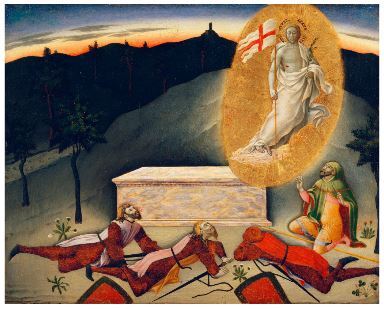Warm sunlight glows from the horizon in Jen Mazza’s painted landscape, The Resurrection* (top image). Rich blue and red-orange hues stretch across the sky as the light of dawn emerges. Distant hills and trees remain submerged in darkness and yet a large hill in the foreground is brightly illuminated. The painting’s title gives a clue to the source of this mysterious light: as the sun rises, renewing the world each day, Jesus’ Resurrection symbolizes renewal of life for humanity.
The painting, made in 2010, is based on an Italian painting from the 15th century (photo below). Viewers of the original painting would have recognized this subject by its figures and symbols, elements that are absent from Mazza’s contemporary version. The risen Christ is seen floating above a sarcophagus as awakened soldiers watch with wonder. Surrounded by brilliant gold pigment, and bearing the marks of the Crucifixion, Jesus triumphantly holds a banner symbolizing victory over death and an olive branch of peace. Mazza’s creation emphasizes the majesty of light and landscape. Notably, she retained the light on the hillside, reflected from Jesus’ divine emanation, and the golden sparkling stars, reinforcing the regal nature of Christ and the heavens. In her innovative recreation, only the illuminated hillside serves as a signal toward the miraculous event, and a reminder of the lasting impact of Jesus’ Resurrection.

Why do artists emulate works from the past? There are many reasons for this frequent practice; artists learn from and are inspired by earlier artists’ work. Mazza is interested in exploring materials of the past to influence the present. She believes that what we seek to see in life is often hidden in plain sight, an idea uniquely presented in this luminous artwork. Her creation of a new work of art that springs forth from a Renaissance painting leaves a striking impression on our idea of Old Master paintings, their importance and use, and the meaning of the Resurrection today. Without the figures to focus on, we are left to ponder the lasting power and impact of Christ on the serene, glowing world before our eyes.

Author Joanna Reiling Lindell is the director and curator of the







